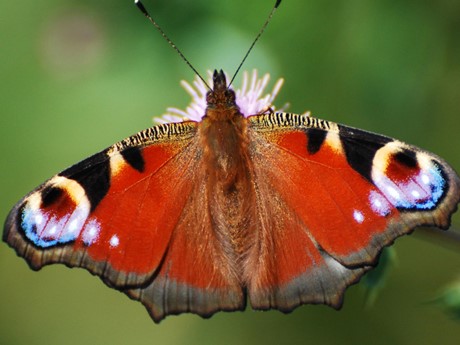UK Trees: causes of yellowing leaves and early autumn tinting
Alex Marshall, 18/08/2023
Here in the UK we are beginning to see the first signs of autumn: fruits ripening, swifts departing and leaves beginning to tint. The Nature’s Calendar project records ‘First’ and ‘Full’ autumn tinting – this is when the leaves begin to change colour, from green to yellow, red or bronze.
Sometimes autumn tinting can be difficult to accurately identify. This is because leaves can change colour for a variety of reasons. Read on for some examples of other causes of leaf tinting.

Beech leaves turning brown at the tips. Credit: Peter Gordon Smith/Nature's Calendar
Insect damage
Insect damage is a common cause of leaf yellowing. Usually, insect damage causes specific characteristics in the affected leaves that can help us distinguish insect leaf damage from autumn tinting. Perhaps the most well-known and wide-spread example of this in the UK is the impact of horse chestnut leaf miner moth.
The larvae of the moth ‘mine’ inside the leaves of the horse chestnut tree, leaving brown coloured patches in the spaces between the leaf veins. These patches appear in the summer and begin in the lower canopy, eventually spreading upwards to cover the entire tree, making the tree look as though it is under-going an early autumn.
Other insect pests that attack the foliage or roots of plants will also often cause leaf yellowing. Examples include sap-sucking aphids, red spider mites, whiteflies, and root feeders such as vine weevil and cabbage root fly.

Symptoms of horse chestnut leaf miner . Credit: Kate Lewthwaite/Nature's Calendar
Infection
There are many disease-causing pathogens of trees - fungal, bacterial and viral. Many diseases are specific to certain trees, so it's beneficial to understand the relationship between tree species and their respective pathogens.
For example, horse chestnut leaf blotch is caused by a fungus called Phyllosticta paviae (syn. Guignardia aesculi). Trees infected by this disease show irregular brown patches on the leaves with distinctive yellow edges, and similar to the leaf miner, they usually appear during the summer.
Cherry trees can be affected by two fungi, namely cherry leaf scorch and cherry leaf spot (Apiognomonia erythrostoma and Blumeriella jaapii). These cause their leaves to look brown and wilted in the summer and they often remain on the tree in winter.
Rusts, powdery mildews, downy mildews, and other diseases can all cause yellowing of all or part of the leaf. This includes diseases that attack the tree's root system (e.g. honey fungus, Phytophthora root rot) or the water-conducting tissues (e.g. Verticillium wilt) .

Yellowing leaves on an oak infected with powdery mildew. Credit: Peter Gordon Smith / Nature's Calendar

Horse chestnut leaf blotch. Credit: Ben Lee/WTML
Environmental conditions
Leaves with brown edges may be exhibiting a condition called leaf scorch, often a result of environmental stress. Unlike infections, leaf scorch is a non-infectious, physiological response to unfavourable environmental conditions and is not caused by fungi, bacteria, or viruses.
Urban trees are especially prone to leaf scorch, especially in areas with heavy traffic flow, root compaction, spring droughts, or unseasonably high temperatures. In addition, waterlogged conditions can lead to leaf yellowing.
Newly planted young trees are particularly susceptible to these environmental stressors, as their root systems have yet to fully establish in the surrounding soil.

Autumn oak leaves. Credit: Laurie Campbell/WTML
Tree or leaf damage
When you observe browning on shoots or localised patches of leaves, it often indicates a disruption in moisture reaching the affected parts. Tracing the shoot back to the trunk can sometimes reveal sources of the problem, such as cankers, squirrel damage or broken branches.
New leaf flush
Sometimes a flush of new leaves may exhibit a reddish hue. This is attributed to the accumulation of anthocyanins, a pigment that forms due to a high sugar concentrations in the leaf. Anthocyanins serve a vital protective role, shielding the young leaves from potential light damage that chlorophyll would typically absorb.

Localised damage has left this branch with yellowing leaves. Credit: Peter Gordon Smith/Nature's Calendar

A flush of new leaves. Credit: Peter Gordon Smith/Nature's Calendar
Nutrition
Leaves turning yellow may also be a sign of nutrient deficiency. Depending on the specific nutrient in question, either older or younger leaves could be affected first, and the discoloration might appear throughout the whole leaf or just along its edges.
Record autumn leaf tint
An increasing number of pests and diseases are targeting the UK's trees, some with dire consequences.
So, if you’ve considered all of these possible explanations for leaf discolouration and concluded that the tree or shrub is genuinely displaying autumn tinting, then it's time to record your observation with Nature’s Calendar!
If you're keen to delve deeper into tree pest and disease identification, explore the Woodland Trust's tree pests and diseases pages. There, you'll find key details on the major tree pests and diseases, including symptoms, potential outcomes, and how you can report them.
